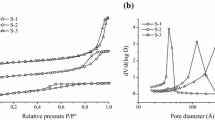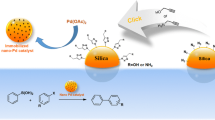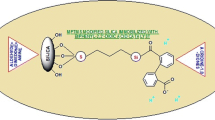Abstract
Chiral pyridinebis(oxazoline) (pybox) ligands can be efficiently immobilized onto silica through position 4 of the pyridine ring. The crucial intermediate in this strategy is 4-chloropybox, which is prepared in good yield from chelidamic acid. 4-Chloropybox reacts with p-hydroxybenzaldehyde and p-aminophenol to give two intermediates (pybox-CHO and pybox-NH2) that allow to introduce the formyl and amino groups able to link to spacers with triethoxysilylgroups. The modified ligands and their ruthenium complexes are immobilized by grafting onto pre-formed silicas or, alternatively, the support is created by sol-gel synthesis using the functionalizedchiral ligand as a silica monomer. In this way it is possible to create a library where the variation involves the support rather than the catalyst. The aim of this approach is to study the influence of different parameters, such as the textural properties of the support and the immobilization method, on the functionalization and catalytic performance. Some of the immobilized complexes are compared as heterogeneous catalysts in the cyclopropanation reaction of styrene with ethyl diazoacetate.
Similar content being viewed by others
References
Blaser, H.-U., Enantioselective catalysis in fine chemicals production, Chem. Commun., (2003) 293–296.
De Vos, D. E., Vankelecom, I. F. J. and Jacobs, P. A. (eds.), Chiral Catalysts Immobilization and Recycling, Wiley-VCH, Weinheim, 2000.
Altava, B., Burguete, M. I., Fraile, J. M., García, J. I., Luis S. V., Mayoral, J. A. and Vicent, M. J., How important is the inert matrix of supported enantiomeric catalysts? Reversal of topicity with two polystyrene backbones, Angew. Chem. Int. Ed., 39 (2000) 1503–1506.
Rechavi, D. and Lemaire, M., Enantioselective catalysts using heterogeneous bis(oxazoline) ligands: which factors influence the enantioselectivity?, Chem. Rev., 102 (2002) 3467–3494.
Fraile, J. M., García, J. I., Mayoral, J. A., Tarnai, T. and Harmer, M. A., Bis(oxazoline)-copper complexes, supported by electrostatic interactions, as heterogeneous catalysts for enantioselective cyclopropanation reactions: influence of the anionic support, J. Catal., 186 (1999) 214–221.
Fernández, A. I., Fraile, J. M., García, J. I., Herrerías, C. I., Mayoral, J. A. and Salvatella, L., Reversal of enantioselectivity by change of solvent with clay-immobilized bis(oxazoline)-copper catalysts, Catal. Commun., 2 (2001) 165–170.
Fraile, J. M., García, J. I., Harmer, M. A., Herrerías, C. I., Mayoral, J. A., Reiser, O. and Werner, H., Immobilisation of bis(oxazoline)-copper complexes on clays and nanocomposites. Influence of different parameters on activity and selectivity, J. Mater. Chem., 12 (2002) 3290–3295.
Burguete, M. I., Fraile, J. M., García, J. I., García-Verdugo, E., Luis, S. V. and Mayoral, J. A., Polymer-supported bis(oxazoline)-copper complexes as catalysts in cyclopropanation reactions, Org. Lett., 2 (2000) 3905–3908.
Burguete, M. I., Fraile, J. M., García, J. I., García-Verdugo, E., Herrerías, C. I., Luis, S. V. and Mayoral, J. A., Bis(oxazoline)-copper complexes covalently bonded to insoluble support as catalysts in cyclopropanation reactions, J. Org. Chem., 66 (2001) 8893–8901.
Orlandi, S., Mandoli, A., Pini, D. and Salvadori, P., An insoluble polymer-bound bis-oxazoline copper(II) complex: a highly efficient heterogeneous catalyst for the enantioselective Mukaiyama aldol reaction, Angew. Chem. Int. Ed., 40 (2001) 2519–2521.
Hallman, K. and Moberg, C., Polymer-bound bis(oxazoline) as a chiral catalyst, Tetrahedron: Asymmetry, 12 (2001) 1475–1478.
Rechavi, D. and Lemaire, M., Heterogenization of a chiral bis(oxazoline) catalyst by grafting onto silica, Org. Lett., 3 (2001) 2493–2496.
Corma, A., García, H., Moussaif, A., Sabater, M. J., Zniber, R. and Redouane, A., Chiral copper(II) bisoxazoline covalently anchored to silica and mesoporous MCM-41 as a heterogeneous catalyst for the enantioselective Friedel-Crafts hydroxyalkylation, Chem. Commun., (2002) 1058–1059.
Nishiyama, H., Itoh, Y., Sugawara, Y., Matsumoto, H., Aoki, K. and Itoh, K., Chiral ruthenium(II)-bis(2-oxazolin-2-yl)pyridine complexes. Asymmetric catalytic cyclopropanation of olefins and diazoacetates, Bull. Chem. Soc. Jpn., 68 (1995) 1247–1262.
Nishiyama, H., Yamaguchi, S., Kondo, M. and Itoh, K., Electronic substituent effect of nitrogen ligand in catalytic asymmetric hydrosilylation of ketones: chiral 4-substituted bis(oxazolinyl)pyridines, J. Org. Chem., 57 (1992) 4306–4309.
Evans, D. A., Kozlowski, M. C., Murry, J. A., Burgey, C. S., Campos, K. R., Connel, B. N. and Staples, R. J., C 2 -symmetric copper(II) complexes as chiral Lewis acids. Scope and mechanism of catalytic enantioselective aldol additions of enolsilanes to (benzyloxy)acetaldehyde, J. Am. Chem. Soc., 121 (1999) 669–685.
Schaus, S. E. and Jacobsen, E. N., Asymmetric ring opening of meso epoxides with TMSCN catalyzed by (pybox)lanthanide complexes, Org. Lett., 2 (2000) 1001–1004.
Iwasa, S., Maeda, H., Nishiyama, K., Tsushima, S., Tsukamoto, Y. and Nishiyama, H., A highly enantioselective 1,3-dipolar cycloaddition reaction in alcoholic media: Ni(II)-pybox-tipsom catalyst, Tetrahedron, 58 (2002) 8281–8287.
Cornejo, A., Fraile, J. M., García, J. I., Gil, M. J., Legarreta, G., Luis, S. V., Martínez-Merino, V. and Mayoral, J. A., The first immobilization of pyridine-bis(oxazoline) chiral ligands, Org. Lett., 4 (2002) 3927–3930.
Anderson, H., Jönsson, C. Moberg, C. and Stemme, G., Consecutive microcontact printing ligands for asymmetric catalysis in silicon channels, Sensors Actuators B 79 (2001) 78–84.
Armistead, C. G., Tyler, A. J., Hambleton, F. H., Mitchell, S. A. and Hockey, J. A., The surface hydroxylation of silica, J. Phys. Chem., 73 (1969) 3947–3953.
Blitz, J. P., Meverden, C. C. and Diebel III, R. E., Reactions of dibutylmagnesium with modified silica gel surfaces, Langmuir, 14 (1998) 1122–1129.
Adima, A., Moreau, J. J. E. and Man, M. W. C., Chiral organic-inorganic solids as enantioselective catalytic materials, J. Mater. Chem., 7 (1997) 2331–2333.
Adima, A., Moreau, J. J. E. and Man, M. W. C., Immobilization of rhodium complexes in chiral organic-inorganic hybrid materials, Chirality, 12 (2000) 411–420.
Hesemann, P. and Moreau, J. J. E., Novel silica-based hybrid materials incorporating binaphthyl units: a chiral matrix effect in heterogeneous asymmetric catalysis, Tetrahedron: Asymmetry, 11 (2000) 2183–2194.
Bied, C., Gauthier, D., Moreau, J. J. E. and Man, M. W. C., Preparation and characterization of new templated hybrid materials containing a chiral diamine ligand, J. Sol-Gel Sci. Tech., 20 (2001) 313–320.
Macquarrie, D. J., Jackson, D. B., Mdoe, J. E. G. and Clark, J. H., Organomodified hexagonal mesoporous silicates, New J. Chem., 23 (1999) 539–544.
Tanev, P. T. and Pinnavaia, T. J., Mesoporous silica molecular sieves prepared by ionic and neutral surfactant templating: a comparison of physical properties, Chem. Mater., 8 (1996) 2068–2079.
Author information
Authors and Affiliations
Corresponding author
Rights and permissions
About this article
Cite this article
Cornejo, A., Fraile, J.M., García, J.I. et al. Immobilizing a single pybox ligand onto a library of solid supports. Mol Divers 6, 93–105 (2003). https://doi.org/10.1023/B:MODI.0000006838.15630.97
Issue Date:
DOI: https://doi.org/10.1023/B:MODI.0000006838.15630.97




